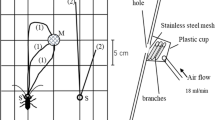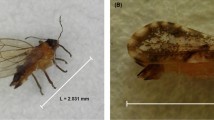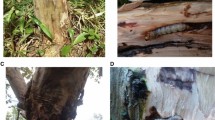Abstract
WAY1 has reported that the coreid bug Theraptus sp. is the cause of nutfall and gumosis of coconuts in East Africa. During more recent investigations to discover economical methods of combating this pest, it has been found that Theraptus sp. is only one of at least four insect pests causing either nutfall or gumosis or both. The larvæ of the weevil Diocalandra frumenti F. will cause both nutfall and particularly gumosis of immature nuts. Mansfield-Aders2 noted the presence of D. frumenti in coconuts in Zanzibar and suggested that it might be a cause of nutfall and gumosis. D. frumenti thrives best in areas infested by Theraptus sp. and Anoplolepis longipes Jerd. It is preyed upon by both Anoplolepis custodiens Smith and Œcophylla smaragdina L., var. longinoda Latr. The larvæ of the moth Lamoria sp. cause considerable nutfall in palms foraged by A. longipes and Pheidole sp. by boring into and eating the bases of the young nuts. A major cause of nutfall in areas where Theraptus sp., D. frumenti and Lamoria sp. have been either eradicated or controlled by insecticides is the ant Polyrhacis schistacea Gerst., vars. rugulosa Mayr and militaris F. These ants nest both in the ground and in the palms, and feed mostly on pollen and nectar. They are so efficient at removing the nectar from flowering nuts that they remove the lining of the stigmata and prevent fertilization. In palms heavily foraged by Polyrhacis sp. complete loss of nuts occurs.
This is a preview of subscription content, access via your institution
Access options
Subscribe to this journal
Receive 51 print issues and online access
$199.00 per year
only $3.90 per issue
Buy this article
- Purchase on Springer Link
- Instant access to full article PDF
Prices may be subject to local taxes which are calculated during checkout
Similar content being viewed by others
References
Way, M. J., Nature, 168, 302 (1951).
Mansfield-Aders, W., Bull. Ent. Res., 10, 145 (1920).
Van Tiel, N., Bull. Ent. Res., 43, 413 (1952).
Author information
Authors and Affiliations
Rights and permissions
About this article
Cite this article
VANDERPLANK, F. Causes of Coconut Nutfall and Gumosis. Nature 172, 315–316 (1953). https://doi.org/10.1038/172315b0
Issue Date:
DOI: https://doi.org/10.1038/172315b0
Comments
By submitting a comment you agree to abide by our Terms and Community Guidelines. If you find something abusive or that does not comply with our terms or guidelines please flag it as inappropriate.



